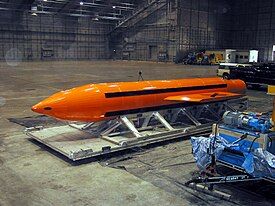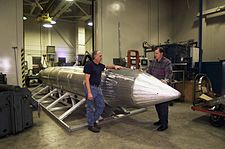Here's Everything that you will ever need to know about MOAB
GBU-43/B Massive Ordnance Air Blast
"MOAB" redirects here. For other uses, see Moab (disambiguation).
| GBU-43/B Massive Ordnance Air Blast | |
|---|---|
 | |
| Type | Conventional bomb |
| Place of origin | United States |
| Service history | |
| In service | Since 2003 |
| Used by | United States Air Force |
| Production history | |
| Designer | Air Force Research Laboratory |
| Designed | 2002 |
| Manufacturer | McAlester Army Ammunition Plant |
| Produced | 2003 |
| Specifications | |
| Weight | 10,300 kg (22,600 lb) |
| Length | 9.1885 m (30 ft 1.75 in) |
| Diameter | 103 cm (40.5 in) |
| Filling | H-6 |
| Filling weight | 8,500 kg (18,700 lb) |
| Blast yield | 11 tons TNT (46 GJ) |
The GBU-43/B Massive Ordnance Air Blast (MOAB pronounced /ˈmoʊ.æb/, commonly known as the Mother of All Bombs) is a large-yield conventional (non-nuclear) bomb, developed for the United States military by Albert L. Weimorts, Jr. of the Air Force Research Laboratory.[1] At the time of development, it was touted as the most powerful non-nuclear weapon ever designed.[2] The bomb was designed to be delivered by a C-130 Hercules, primarily the MC-130E Combat Talon I or MC-130H Combat Talon II variants. The MOAB is the largest conventional bomb ever used in combat after being deployed in Afghanistan on 13 April 2017. [3]
In 2007, Russia tested its "Father of All Bombs", which is claimed to be four times as powerful as the MOAB.[4
Operational history
| This section documents a recent military action. Information may change rapidly as the event progresses, and initial news reports may be unreliable. The last updates to this section may not reflect the most current information. (April 2017) (Learn how and when to remove this template message) |
See also: April 2017 Nangarhar airstrike
MOAB was first tested with the explosive tritonal on 11 March 2003, on Range 70 located at Eglin Air Force Base in Florida. It was again tested on 21 November 2003.[2]
Aside from two test articles, the only known production is of 15 units at the McAlester Army Ammunition Plant in 2003 in support of the Iraq War.[citation needed]
On 13 April 2017, a MOAB was dropped on an ISIS cave complex in Nangarhar Province, Afghanistan.[5] It was the first use of the bomb on the battlefield.[6][7]
Evaluations
The basic operational concept bears some similarity to the BLU-82 Daisy Cutter, which was used to clear heavily wooded areas in the Vietnam War and in Iraq to clear mines and later as a psychological weapon against the Iraqi military. After the psychological impact of the BLU-82 on enemy soldiers was witnessed, and no BLU-82 weapons remained, the MOAB was developed partly to continue the ability to intimidate Iraqi soldiers. Pentagon officials had suggested their intention to use MOAB as an anti-personnel weapon, as part of the "shock and awe" strategy integral to the 2003 invasion of Iraq.[8]
The MOAB is not a penetrator weapon and is primarily intended for soft to medium surface targets covering extended areas and targets in a contained environment such as a deep canyon or within a cave system.[9] However, multiple strikes with lower yield ordnance may be more effective and can be delivered by fighter/bombers such as the F-16 with greater stand-off capability than the C-130 and C-17.[citation needed] High altitude carpet-bombing with much smaller 230-to-910-kilogram (500 to 2,000 lb) bombs delivered via heavy bombers such as the B-52, B-2, or the B-1 is also highly effective at covering large areas.[10]
Cost
The bomb costs $16 million per unit, according to Deagel, a "Guide to Military Equipment and Civil Aviation."



Comments
Post a Comment